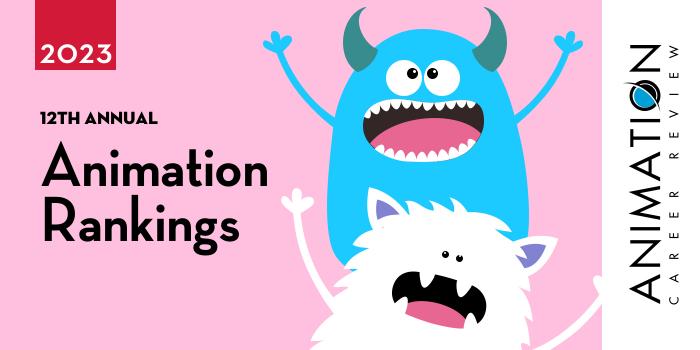
35+ Years of Shaping Entertainment and Pop Culture - From Oscar and GRAMMY-winners, to animators, to creative directors and entrepreneurs, our graduates make significant contributions to their industries. Learn More.

| Ranking | School | City |
|---|---|---|
| 1 | University of North Carolina School of the Arts | Winston-Salem |
| 2 | North Carolina State University | Raleigh |
| 3 | University of North Carolina - Wilmington | Wilmington |
| 4 | East Carolina University | Greenville |
| 5 | University of North Carolina - Charlotte | Charlotte |
Our 2023 ranking -our twelfth annual- of the top animation school programs in North Carolina. For an explanation of the ranking criteria, click here.

University of North Carolina School of the Arts (UNCSA) houses the School of Filmmaking and the School of Design & Production. The School of Filmmaking is home to Animation BFA, and the School of Design & Production (S&P) is stand-alone design and production conservatory that houses the Animatronics MFA.
The Animation BFA requires 121 credit hours of study. The first year consists of liberal arts and foundations courses in filmmaking. At the end of the first year, students will complete a portfolio for entry into the Animation Program. Once admitted, students will begin exploring character design, storytelling, lighting techniques, drawing, and props. Third year students will complete a three-minute animation project and begin working on the final fourth-year project. This final project consists of a five minute film that will serve as the BFA Thesis.
During the junior or senior years, students may complete an internship or independent study as well as upper level elective courses to enhance the degree. UNCSA Animation BFA students have interned at major studios such as Sony Pictures Imageworks and Stargate Studios.
Graduates of the Animation BFA Program at UNCSA have worked with Cartoon Network and Prologue Pictures, among others.
The Animatronics MFA in the School of D&P launched in Fall 2021. This hybrid, three-year program blends electronics and animation. Students will take hands-on, immersive courses that explore animatronic programming and design, engineering and infrastructure of animatronic figures, sculpting, 3D printing, and project management. Other program benefits include seminars and workshops led by professionals in the industry and access to a 100,000 square feet of state-of-the-art production space.
The Animatronics MFA Program at University of North Carolina School of the Arts culminates with a final project (thesis) conducted in collaboration with an advisor.
Graduates of the Animatronics MFA Program at University of North Carolina School of the Arts have launched their careers at places such as Nickelodeon, Universal Studios, and Walt Disney Imagineering.
North Carolina School of the Arts was established in 1963 by the N.C. General Assembly. The school opened in 1965, becoming the nation’s first public arts conservatory. North Carolina School of the Arts became part of the University of 17-campus North Carolina System in 1972, and was renamed University of North Carolina School of the Arts. Today, UNCSA serves more than 1,300 students enrolled in dozens of programs across five schools. University of North Carolina School of the Arts is accredited by the Southern Association of Colleges and Schools Commission on Colleges (SACSCOC).

The College of Design at North Carolina State University (NC State) began as the School of Architecture and Landscape Design in 1946. It was renamed the School of Design in 1948 and the College of Design in 2000. Today, the College provides programs in architecture, art and design, design studies, graphic and experience design, industrial design, and landscape architecture and environmental planning. Programs are available at all levels—including the doctorate.
Other College of Design highlights include swing studios in other majors; study abroad experiences in places such as Greece, Chile, and Prague; an interdisciplinary first-year experience; workshops; and internship opportunities.
The College of Design at NC State also has several pathways to study animation. Housed in the College’s Department of Art + Design are the Bachelor of Art + Design (BAD) and Masters of Art + Design (MAD) Programs. A 15 credit hour Art + Design Minor consisting of courses such as Animation, Three-Dimensional Design, Drawing, Color and Light, and Sequential Imaging, is also available.
Department of Art + Design programs are highly multidisciplinary, allowing students to study both traditional disciplines and emerging techniques. Examples include animation, VR/AR, visual composition, interactive and computational media, and visual effects. Electives allow additional opportunities to focus the BAD. Examples of required courses and elective options include Advanced Digital Techniques, Animation I. Art + Design Laboratory I-II, Creative Technology Studio I-III, Drawing I-II, Visualization I-II, Digital Motion, Sequential Imaging, Color and Light, Digital Modeling, Digital Representation, and Writing About Film.
Undergraduate students will move from foundation courses in the first and second years to intermediate and advanced classes in the final two years of the program. Students will leave the Bachelor of Art and Design program with a final project and a polished portfolio of their work.
The NC State MAD Program emphasizes experimental media arts and provides the same opportunities to study animation as the BAD Program does. Examples of past MAD elective options include 3D Animation, Seminar in Animation, Special Effects, Creative Coding, Digital Motion, Visualizing Narrative, Digital Modeling, Sequential Imaging, and Business of Design.
During the final years of the program, MAD students will have the option to produce a project in animation, interactive media, or other area of their choosing, or complete a research-based study or paper.
NC State Art + Design graduates work in fields such as animation, digital special effects, multimedia, illustration, filmmaking, and software design. Some graduates go on to launch their own studios and freelance businesses, while others are become art and design educators.
North Carolina State University employs more than 9,000 faculty and staff members serving 36,000+ students, making it the largest university in the University of North Carolina System. Established in 1887 as a land-grant institution focusing in agriculture and engineering, NC State offers more than 300 degree programs across 11 colleges, 68 departments, and The Graduate School. North Carolina State University is accredited by the Southern Association of Colleges and Schools Commission on Colleges (SACSCOC).

The College of Arts and Sciences at University of North Carolina Wilmington (UNCW) is home to the Department of Art and Art History, which houses the interdisciplinary Digital Arts Program. Within the Program are two pathways for animators including the Digital Arts BA and a Minor. The Digital Arts BA has an optional Concentration in Interactive Graphics. Also housed in the College of Arts and Sciences is the Computer Science (CS) Program. CS students can add a Digital Arts Concentration, which leads to a BS in CS/Digital Art.
Students in the interdisciplinary Digital Arts BA Program will learn to design 3D graphics and interactive user experiences for film animation, VR/AR, digital art, games, and 3D animation applications. Course examples include Computer Animation, Computer Gaming, Digital Visual Effects, Life Drawing, Visual Design for Multimedia, and Computer Graphics Programming. A Digital Arts Capstone (Portfolio Project) is also part of the program. Students will complete the Capstone during the last year in the major and present it in a campus venue.
The UNCW BS in CS/Digital Art Program requires 55 credit hours in the CS Core and 24 credit hours of study in the concentration. Course examples for the program include Computer Networks, Design and Analysis of Algorithms, Programming Languages, and Software Engineering. In the concentration, students may take courses such as Computer Animation, Film Production, Digital Video Production, 3D Computer Graphics, Multimedia Systems, Graphic Design, and Tools & Literacy.
Graduates of the Digital Arts Programs at University of North Carolina Wilmington are prepared to pursue positions at animation, VFX, and game design studios; graphic design firms; companies that specialize in using VR/AR for entertainment, training, and education; video production companies; and places that utilize HCI such as theaters, galleries, and museums, architectural firms, and engineering companies.
Established in 1946, University of North Carolina Wilmington is part of the part of the 17-campus University of North Carolina System. The school serves approximately 17,845 students enrolled in more than 100 programs across five colleges and schools. The University of North Carolina Wilmington is accredited by the Southern Association of Colleges and Schools Commission (SACSCOC).

The College of Fine Arts and Communication at East Carolina University (ECU) houses the National Association of Schools of Art and Design (NASAD) accredited School of Art and Design (SoAD). Within the school is an Art BFA Program that allows students to explore different disciplines, while focusing on a concentration in a specific area. For artists seeking a pathway to study animation, the Art BFA Program has an Animation/Interactive Design Concentration.
All SoAD concentrations are supported by a guild that provides activities to enhance the curriculum. Guild activities include visiting artists and designers for talks and workshops, student travel to conferences, research opportunities, and support on creative projects. Other program benefits include partnerships with local arts organizations, hands-on learning, internships, study abroad opportunities, and access to career development services.
The Art BFA at East Carolina University requires 30 credit hours in the concentration. Coursework for the Animation/Interactive Design Concentration explores animation, video art, game design, and interactive design. Students will complete a senior exhibition, portfolio, reel, or film to graduate from the program. This culminating experience prepares students to pursue a variety of professional roles in animation, games, TV/film, and advertising, among others.
Chartered as East Carolina Teachers Training School in 1907, East Carolina University is the only public university in the state with a dental school, medical school, and college of engineering. ECU serves nearly 29,000 students enrolled in more than 200 undergraduate, graduate, and minor programs across 12 colleges and schools, making it one of the top five largest universities in North Carolina. Part of the University of North Carolina System of 17 institutions, East Carolina University is accredited by the Southern Association of Colleges and Schools Commission on Colleges (SACSCOC).

The College of Arts + Architecture (COA+A) at University of North Carolina Charlotte (UNC Charlotte) houses the Department of Art & Art History. Within the Department is one pathway to study animation. Consisting of 120 credit hours, the Department’s Art Program has a Digital Media Concentration that requires 79 credit hours in the major. Course examples include 3D Modeling and Animation, Animation Production, Video Art, Interactive Art and Design, Digital Compositing, Advanced 3D Modeling and Digital Fabrication, Game Design and Graphics, and Topics in Digital Media.
All Art Program students will complete Senior Seminar, and Senior Thesis I and II. The Art BFA is a professional degree program that takes four years to complete.
Students will graduate from the UNC Charlotte Art Program with a professional portfolio of their best work. Program alumni are prepared to pursue careers in areas such as animation, film and video, television, advertising, multimedia design, and web design.
University of North Carolina Charlotte is accredited by the Southern Association of Colleges and Schools Commission on Colleges (SACSCOC). Founded in 1946, UNC Charlotte serves approximately 29,550 students enrolled in more than 200 undergraduate, graduate, and doctoral programs across nine colleges. University of North Carolina Charlotte is a public research university and the third largest school in the 16-campus UNC System.